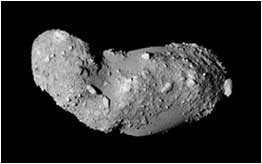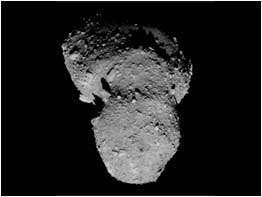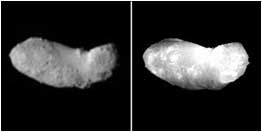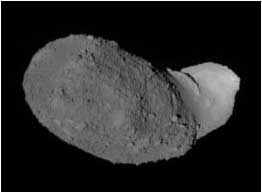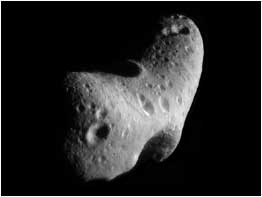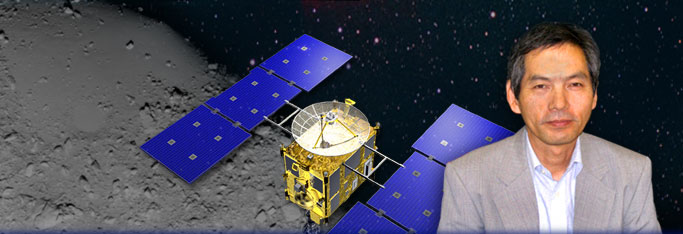 |
|||||
Q. Could you tell us about your role in this mission? Hayabusa is an engineering explorer, but many asteroid and planetary scientists are involved and are carrying out scientific exploration and research activities. I'm in charge of scientific matters to ensure the efficient progress of these scientific activities. My specialty is collisional evolution of asteroids. Q. Why was Itokawa chosen? It was chosen as the asteroid was appropriate in terms of engineering and technology, which means that even a small rocket, with little energy, can reach it. However, scientifically speaking, this asteroid has high exploration value as well. Itokawa is a near-Earth asteroid which was discovered by an American in 1998, and was named after Dr. Hideo Itokawa who was a father of Japan's rocket development. When the Hayabusa mission was initiated in 1994, another asteroid called Nereus had been selected as its target. However, as the mission was fleshed out, such problems as the explorer's weight and timing issues came arose, which eventually forced us to change the target asteroid. As a matter of fact, Itokawa was selected on the third change.
We previously had a meeting, including many scientists from overseas, to predict the profile of Itokawa. Back then, most scientists speculated the existence of regolith, but I had rather a different opinion; I had imagined a bare rock surface. So it was a surprise that the surface is actually covered with lots of rocks and also with some regolith. And it's very interesting how clearly defined they are in their distribution. I thought that these images were quite different from images of large asteroids taken by NASA's explorers. Q. What does the distribution of rock and regolith indicate? We can learn about Itokawa's collisional history. In order to do so, we must first study where and what size of particles and rocks are distributed. And then, based on that data, we can presume the frequency and the types of collisions that have occurred, and the size and quantity of fragments produced by those collisions. The emission of fragments differs depending on the composition of the celestial body, which means that, to a certain degree, we'll also be able to surmise that Itokawa's core composition as well. As for particles in the smooth (regolith) zone which are too small for image analysis, we still don't know about their distribution pattern yet. So we're observing how sunbeams reflect off Itokawa, and the strength and coloring of the sunbeams from various directions and angles. The angle between the Sun and an observation point viewed from a celestial body is called a phase angle. When a phase angle is close to 0 degrees and a celestial body receives sunbeams collinearly, the celestial body rapidly brightens up. This property is called an opposition effect. The information of an opposition effect enables us to examine the distinction of rocks and sand, and the composition of the surface. When we did observation by adjusting the phase angle close to 0 degrees with the Sun, Hayabusa and Itokawa positioned collinearly, an opposition effect was seen on Itokawa as well. It will be important to analyze this effect in more detail. Predictions of particle sizes on different landforms are also being looked into because very fine sand or gravel might reflect a landform type; whether it's a place where things roll easily. Q. What do you expect for Hayabusa now? I believe that Hayabusa, even to this point, has made wonderful achievements not only in terms of engineering but also of science. Now, gathering samples is its next big challenge. For that, a candidate landing point has already been selected, but to be honest, I just hope samples are successfully collected no matter where they are from. And even after the mission completion of gathering samples, there will still be some obstacles until they are returned to the Earth. I'm really praying for the sample capsule's safe return. Q. What are your thoughts about the future research on Itokawa? Asteroids are thought to be a result of the evolution of planetesimals, which are formed from debris. After its evolution, asteroids, we can see now, are believed to have been destroyed and reformed repeatedly. An asteroid is a product of destruction. Studying an asteroid like Itokawa, that has a lot of rocks on the surface, will be a great help in finding what types of collisions an asteroid experiences from its birth. It was impossible to see rocks on the asteroids discovered before, as they were under thick regolith. For instance, the regolith of the asteroid Eros is tens of meters thick. When the surface is covered with regolith, the only means of learning about the celestial body are mainly the size and the number of craters on the surface. With Itokawa, we examine its craters of course, but we're also expecting to make new discoveries by studying the distribution of rock size. The data on Itokawa collected by Hayabusa is full of research potential. The observation data we have gained this time will be analyzed from various aspects, for instance, comparing to meteorites that have fallen to the Earth. I believe that the results will have a great impact not only on our group but also on scientists around the world. Research on the history of asteroids, and furthermore, on the history of the Earth and the solar system will be advanced. Q. What do you hope for the future of planetary exploration? Hayabusa is the first step in Japan's small celestial body exploration. There are hundreds of thousands of asteroids, and they are grouped into a few different types based on differences in wavelengths of their surface reflectance (reflectance spectrum). Among those types, the major ones are type S and type C. Asteroids of Type S are bright and are usually thought to be close to chondritic meteorites. Meanwhile, type C are dark and are close to carbonaceous chondrites. Itokawa belongs to type S. It would be great if we could turn planetary exploration into a series, by visiting a type-C asteroid next time. If it's difficult to do it only within Japan, I hope to see Japan leading international planetary exploration in collaboration with scientists overseas. |
|||||
|
